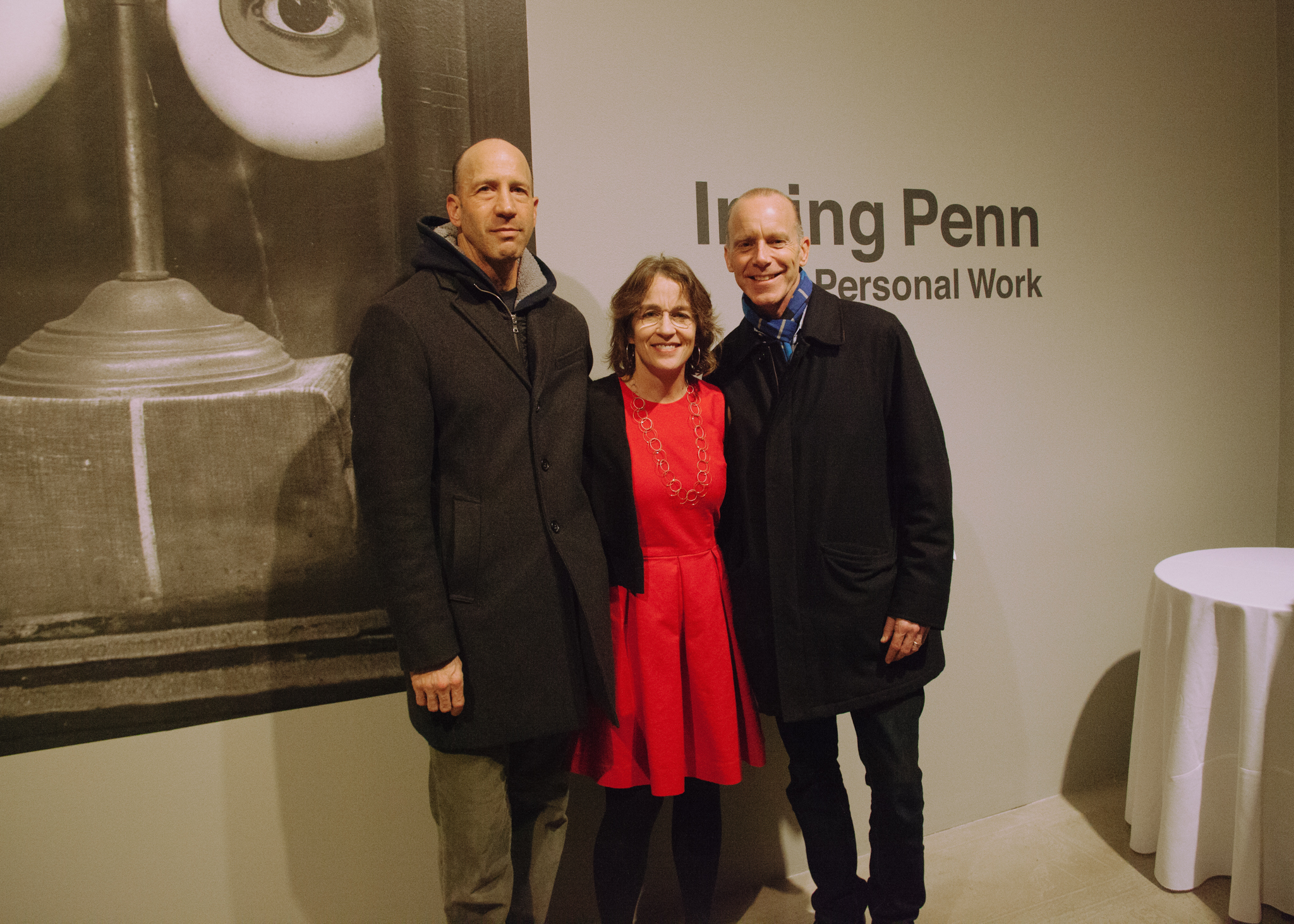Image above: © Irving Penn, Woman Turning Over, New York, 1995 © The Irving Penn Foundation / courtesy Pace and Pace/MacGill Gallery
Pace and Pace/MacGill Gallery presented Irving Penn: Personal Work, a survey of privately produced, uncommissioned photographs by the iconic American photographer Irving Penn (1917–2009). A companion to Irving Penn: On Assignment, presented by the galleries in 2013, the exhibition and its counterpart collectively offer a retrospective glance at the breadth of achievement of Penn’s legendary seven-decade career.

Image above: © Ashley Comer, From the opening reception, Stuart Sproule (left), Kimberly Jones, Gallery Director (Center), and Daniel Rowen (right)
Probably the most prolific and respected photographer of the 20th century, Irving Penn is celebrated for his innovative commercial imagery and groundbreaking editorial contributions to Condé Nast publications. In addition to his professional assignments, however, Penn pursued a variety of personal projects – such as nudes, self-portraits, signage, moving light portraits, and still lifes of seemingly inconsequential objects – to maintain an artistic balance throughout his career. Spanning a variety of subjects and genres, Penn's extensive oeuvre explores the boundaries of personal and public expression, and subsequently art and commerce, through compelling images that expanded the creative limits of the medium. Moreover, his technical mastery of black-and-white and color photography, as well as the platinum printing process, earned him accolades in the realms of both commercial and fine art.
![IP.SV.1580 [17441]_IP, Photograph of Self (F), New York, 1993_LR](http://static1.squarespace.com/static/5702ab9d746fb9634796c9f9/5702b54efd028276f35de678/5702bd1bfd028276f35f18f4/1459797275027/IP.SV_.1580-17441_IP-Photograph-of-Self-F-New-York-1993_LR.jpg?format=original) Image above: © Irving Penn, Photograph of Self (F), New York, 1993 © The Irving Penn Foundation / courtesy Pace and Pace/MacGill Gallery
Image above: © Irving Penn, Photograph of Self (F), New York, 1993 © The Irving Penn Foundation / courtesy Pace and Pace/MacGill Gallery
As early as 1949, just a year before his editorial images of the Paris couture collections would revise the visual aesthetics of fashion photography, Penn began what is considered perhaps his most personal but least well-known body of work: studies of tightly-framed, corpulent nudes that explore the beauty and physicality of the female form.
Unconventional in both subject and composition, the series was also radical in technique, as Penn drastically overexposed, bleached, and then redeveloped his prints to create unusual, stunning tonal effects.
![IP.S.1567 [17719]_The Bath (L) (Dancers Workshop of San Francisco), San Francisco, 1967_HR](http://static1.squarespace.com/static/5702ab9d746fb9634796c9f9/5702b54efd028276f35de678/5702bd1bfd028276f35f190a/1459797275229/IP.S.1567-17719_The-Bath-L-Dancers-Workshop-of-San-Francisco-San-Francisco-1967_HR.jpg?format=original) Image above: © Irving Penn, The Bath (L) (Dancers Workshop of San Francisco), San Francisco, 1967 © The Irving Penn Foundation / courtesy Pace and Pace/MacGill Gallery
Image above: © Irving Penn, The Bath (L) (Dancers Workshop of San Francisco), San Francisco, 1967 © The Irving Penn Foundation / courtesy Pace and Pace/MacGill Gallery
A deft and distinguished practitioner of the still life, Penn embraced the genre from the outset of his photographic career. His first foray was published on the 1943 cover of Vogue at the suggestion of the magazine’s then art director, Alexander Liberman, and by 1947 Penn was producing a multitude of commercial still lifes for the printed page. In the early 1970s, however, he progressively dedicated more time to his private, uncommissioned work in which he transformed miscellaneous detritus into abstracted elements of artistic expression. Whether investigating the visual intrigue of seemingly inconsequential, discarded debris like bones, plumbing fittings and cigarette butts, animal skulls from the collection of the Narodni National Museum in Prague, or vessels from his personal collection, these images demonstrate Penn’s extraordinary ability to create strikingly eloquent compositions from the most unsuspecting materials. As John Szarkowski wrote in the catalogue accompanying Penn’s 1984 retrospective at The Museum of Modern Art, New York:
Until now it [Penn’s work] has demonstrated for photography in our time what must be relearned by most arts in most times: that the apparently inconsequential can be redeemed by artistic seriousness; that a plain vocabulary is the most demanding; that high craft is the just deserts not only of monuments and ceremonial vessels, but of the ordinary baggage of our lives.
![IP.507.5 [AR 648]_Bone Forest, New York, 1980_HR](http://static1.squarespace.com/static/5702ab9d746fb9634796c9f9/5702b54efd028276f35de678/5702bd1bfd028276f35f1934/1459797275430/IP.507.5-AR-648_Bone-Forest-New-York-1980_HR.jpg?format=original) Image above: © Irving Penn, Bone Forest, New York, 1980 © The Irving Penn Foundation / courtesy Pace and Pace/MacGill Gallery
Image above: © Irving Penn, Bone Forest, New York, 1980 © The Irving Penn Foundation / courtesy Pace and Pace/MacGill Gallery
Penn’s photography has been the subject of numerous solo exhibitions worldwide. Recent exhibitions include Irving Penn: Underfoot (2013) at the Art Institute of Chicago and Irving Penn: Beyond Beauty (2015-2018), which is currently on view at the Smithsonian American Art Museum, Washington, D.C., and will travel to five additional venues in the United States. In April 2017, The Metropolitan Museum of Art, New York will present a major retrospective of over 200 of Penn’s photographs to mark the centennial of his birth. His work can be found in both domestic and international museum collections, including the Art Institute of Chicago; Maison Européenne de la Photographie, Paris; The Metropolitan Museum of Art, New York; the Moderna Museet, Stockholm; the Morgan Library and Museum, New York; The Museum of Modern Art, New York; and the National Gallery of Art, Washington, D.C. Penn has published multiple books of photographs: Moments Preserved (1960); Worlds in a Small Room (1974); Inventive Paris Clothes (1977); Flowers (1980); Issey Miyake (1988); Passage (1991); Still Life (2001); A Notebook at Random (2004); Photographs of Dahomey (2004); as well as two books of drawings. Monographs of his work include: Irving Penn (1984); Irving Penn: Master Images (1990); Irving Penn: A Career in Photography (1997); Dancer (2001); Earthly Bodies: Irving Penn’s Nudes, 1949-50 (2002); Irving Penn: Platinum Prints (2005); Irving Penn: Small Trades (2009); Irving Penn: Portraits (2010); Irving Penn: Archæology (2010); Irving Penn: Cigarettes (2012); Irving Penn: Cranium Architecture (2013); Irving Penn: Beyond Beauty (2015); and Irving Penn: Flowers (2015).



